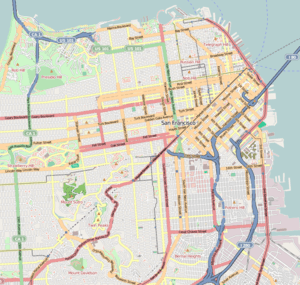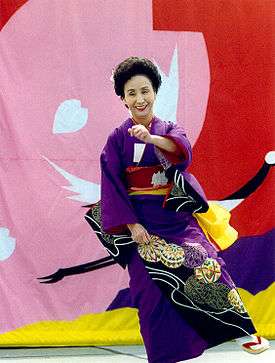Japantown, San Francisco
| Japantown | |
|---|---|
| Neighborhood | |
|
Japan Center of Japantown, with Peace Pagoda and the Sundance Kabuki 8 cinema complex. | |
| Nickname(s): Nihonmachi, Little Osaka, J-Town | |
 Japantown Location within Central San Francisco | |
| Coordinates: 37°47′06″N 122°25′47″W / 37.7851°N 122.4298°W | |
| Country |
|
| State |
|
| City-county | San Francisco |
| Government | |
| • Supervisor | London Breed |
| • Assemblymember | David Chiu (D)[1] |
| • State senator | Scott Wiener (D)[1] |
| • U.S. rep. | Nancy Pelosi (D)[2] |
| Area[3] | |
| • Total | 0.036 sq mi (0.09 km2) |
| • Land | 0.036 sq mi (0.09 km2) |
| Population [3] | |
| • Total | 1,397 |
| • Density | 39,000/sq mi (15,000/km2) |
| Time zone | Pacific (UTC−8) |
| • Summer (DST) | PDT (UTC−7) |
| ZIP code | 94115 |
| Area codes | 415/628 |
Japantown (日本町 Nihonmachi) (also known as J Town or historically as Japanese Town, "Nihonmachi") is a neighborhood in the Western Addition district of San Francisco, California. It comprises about six square city blocks. San Francisco's Japantown is the largest and oldest such enclave in the United States.[4]
Location
The main thoroughfare is Post Street, between Fillmore Street (to the west) and Laguna Street (to the east). The Japantown neighborhood is generally considered to be bordered on the north by Bush or Pine Street, and on the south by Geary Boulevard.

Its focal point is the Japan Center, which opened in 1968,[5] and is the site of three Japanese-oriented shopping centers. The Peace Pagoda, also at the Japan Center, is a five-tiered concrete stupa designed by Japanese architect Yoshiro Taniguchi and presented to San Francisco by the people of Osaka, Japan.
History
Built and settled as part of the Western Addition neighborhood in the 19th and early 20th century, Japanese immigrants began moving into the area following the 1906 earthquake.[6] (Before 1906, San Francisco had two Japantowns, one on the outskirts of Chinatown, the other in the South of Market area. After 1906, San Francisco's main Japantown was in the Western Addition, with a smaller one in the South Park area.[7]) By World War II, the neighborhood was one of the largest such enclaves of Japanese outside Japan, as it took an appearance similar to the Ginza district in Tokyo.[6]

In February 1942, President Franklin D. Roosevelt signed Executive Order 9066, which forced all Japanese of birth or descent, including Japanese American citizens of the United States, to be relocated from the Pacific coast and interned. By 1943 many large sections of the neighborhood remained vacant due to the forced internment. The void was quickly filled by thousands of African Americans who had left the South to find wartime industrial jobs in California as part of the Great Migration.
Following the war, some Japanese Americans returned, followed by new Japanese immigrants as well as investment from the Japanese Government and Japanese companies. However, many did not return to the neighborhood and instead settled in other parts of the city, or out to the suburbs altogether. This was further exacerbated by the city's efforts to rejuvenate the neighborhood initiated by Justin Herman in the Western Addition in the 1960s through the 1980s.[8]
In 1957, San Francisco entered in a sister city relationship with the city of Osaka, hence the nickname "Little Osaka". Osaka is San Francisco's oldest sister city.[9] In commemoration of the 50th anniversary of this relationship, one block of Buchanan Street, in Japantown, was renamed Osaka Way on September 8, 2007.[10]
Government and infrastructure
The San Francisco Police Department Northern Station serves Japantown.[11]
Education
The area is within the San Francisco Unified School District. Rosa Parks Elementary School is located near Japantown. It houses the Japanese Bilingual Bicultural Program (JBBP).[12] In the winter of 2005 Rosa Parks had 233 students, which filled less than half of the school. That winter, SFUSD proposed closing the school and merge it with another elementary school. Parents protested in favor of keeping the school open. SFUSD moved the Japanese Bilingual Bicultural Program into Rosa Parks. As of November 2006, almost half of the students in the regular Rosa Parks program are African-American and one-third of the students in the JBBP program are Japanese.[13]


Attractions and characteristics
The area is home to Japanese cuisine (and some Korean and Chinese) restaurants, supermarkets, indoor shopping malls, hotels, banks and other shops, including one of the few U.S. branches of the large Kinokuniya bookstore chain. Most of these businesses are located in the commercial Japan Center of the neighborhood, in a large shopping mall built in the 1960s as part of urban renewal efforts and is run by Japanese retailer Kintetsu.
Festivals
San Francisco's Japantown celebrates two major festivals every year: The Northern California Cherry Blossom Festival (held for two weekends every April),[14] and the Nihonmachi Street Fair, held one weekend in the month of August.[15]
The Cherry Blossom Festival takes place over the course of two weekends. During the first weekend, the Northern California Cherry Blossom Queen Program takes place at the Kabuki Theatre, where women of Japanese/Japanese-American descent are chosen to represent, learn about, and serve their community.[16] During the Sunday parade, the queen and princesses are presented on a float.
See also
- 49-Mile Scenic Drive
- History of the Japanese in San Francisco
- Japanese American internment
- Japanese American National Library
- Japanese Cultural and Community Center of Northern California
- Japantown — for other Japanese neighborhoods
- Kinmon Gakuen
- Neighborhoods of San Francisco
References
- 1 2 "Statewide Database". UC Regents. Retrieved December 8, 2014.
- ↑ "California's 12th Congressional District - Representatives & District Map". Civic Impulse, LLC.
- 1 2 "Japantown neighborhood in San Francisco, California (CA), 94115 subdivision profile". City-Data.com. Retrieved February 14, 2015.
- ↑ "San Francisco Japantown 100th Anniversary - History of San Francisco's Japantown". Japantown Merchants Association. Retrieved December 16, 2007.
- ↑ Belva Davis (March 28, 1968). Japan Center's Dedication Ceremony. San Francisco Bay Area Television Archive. KPIX Eyewitness News. Retrieved February 8, 2015.
- 1 2 "About Japantown". Japantown San Francisco. Archived from the original on December 20, 2009.
- ↑ Japanese Task Force Inc., Images of San Francisco's Japantown (2005) pp. 7, 9
- ↑ Jofuku, Linda (August 31, 2005). "Preserving Japantown is about people, not just property". San Francisco Chronicle. Retrieved February 8, 2015.
- ↑ "SF-Osaka Sister City Association: 50th Anniversary 2007 - Events". SF-Osaka Sister City Association. Retrieved December 18, 2007.
- ↑ "Osaka Way Unveiling Ceremony". Consulate-General of Japan in San Francisco. Retrieved December 18, 2007.
- ↑ "Northern Station". San Francisco Police Department. Retrieved September 1, 2013.
- ↑ Chen, Adelaide (February 27, 2008). "Japantown Planning Talks Continue". AsianWeek. Retrieved September 1, 2013.
- ↑ Eslinger, Bonnie (November 20, 2006). "School merger unites communities". San Francisco Examiner. Retrieved September 1, 2013.
- ↑ "Northern California Cherry Blossom Festival". Retrieved February 8, 2015.
- ↑ "Nihonmachi Street Fair". Retrieved February 8, 2015.
- ↑ "Northern California Cherry Blossom Festival Queen Program". Retrieved February 8, 2015.
Further reading
- Arnold, Bruce Makoto (February 19, 2009). "The Japanese Ethnopole as Determinant: The Effects of the Japantowns on Second-Generation Japanese-Americans". Hard Times in the Arkansas Delta: 1942-1945: The Japanese American Internment Camps, Fayetteville, AR.
External links
| Wikimedia Commons has media related to Japantown, San Francisco. |
| Wikivoyage has a travel guide for Japantown. |
- Discover San Francisco Japantown
- Japantown Task Force, Inc.
- Japanese Cultural and Community Center of Northern California
- Google Maps view of the Peace Pagoda
- SFcityguides.org: free walking tours of Japantown
Coordinates: 37°47′06″N 122°25′47″W / 37.7851°N 122.4298°W

.svg.png)